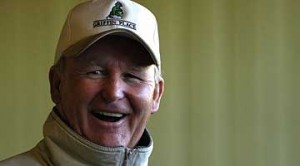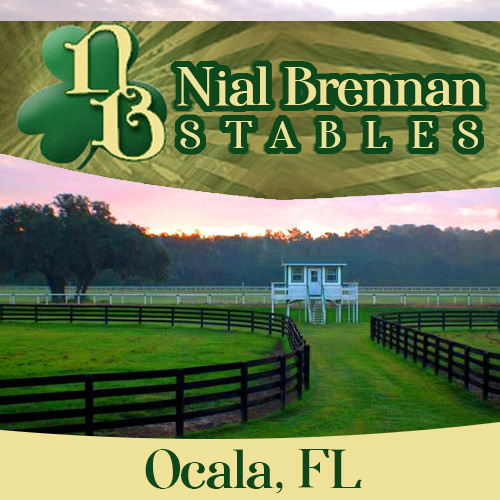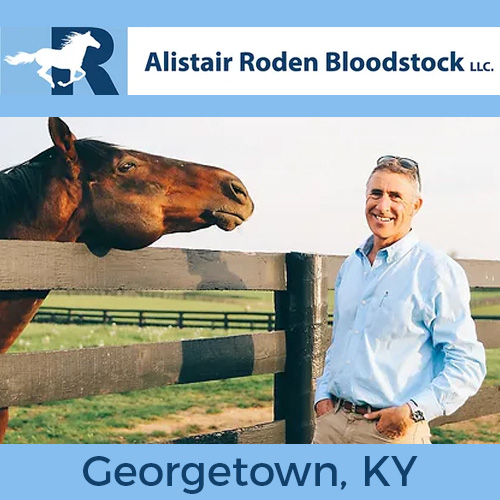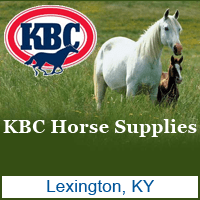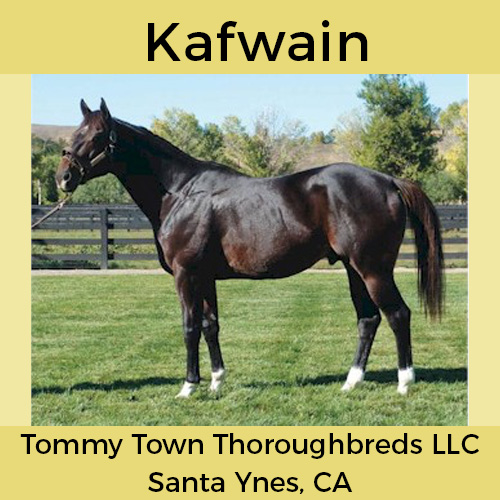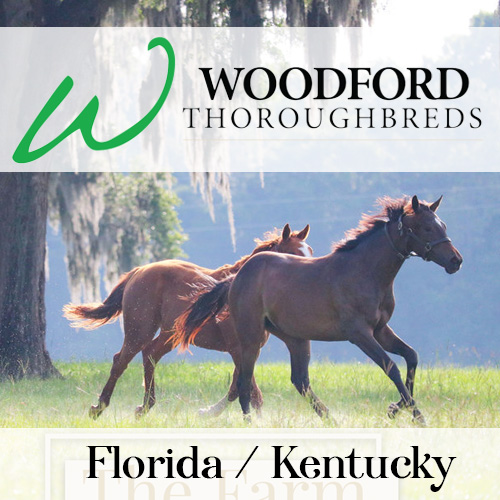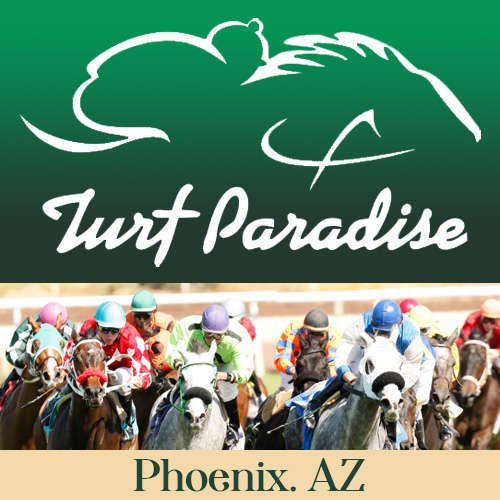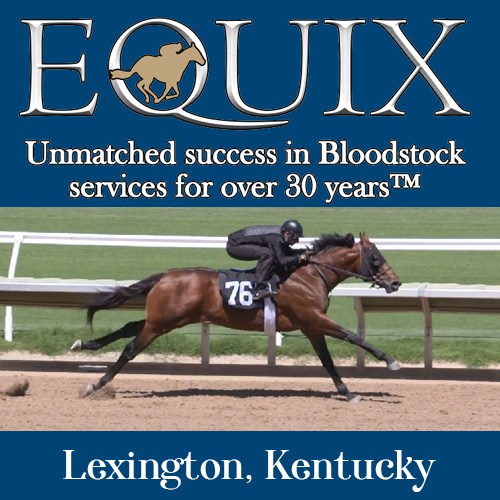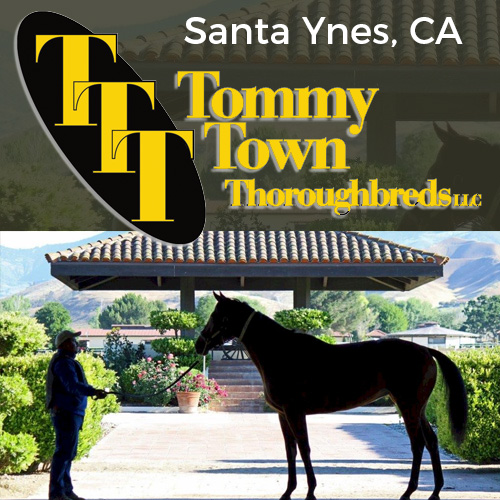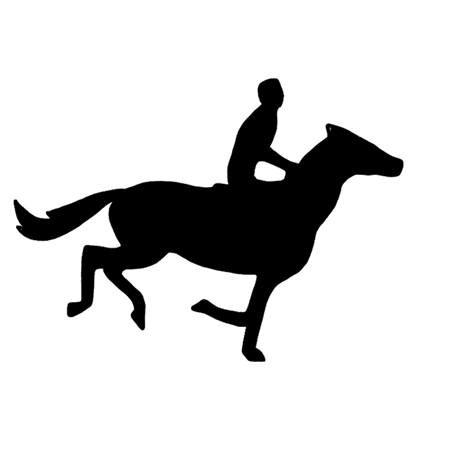The Interviews: Bloodstock Agent & ex-Trainer Greg Gilchrist
After a successful training career in which he trained 1529 winners for purses of over $24 million, Greg Gilchrist handled good horses like Lost In The Fog, Soviet Problem, Work The Crowd, Wild Wonder, Smokey Stover and Victorina. Greg now operates as a bloodstock agent for a select number of clients. Greg talked to us about his life in racing.
TBP: Greg how did you get involved in horse racing, were you from a racing background?
GG: I was actually kind of born into the racetrack scene. My father always told me I was conceived in a tack room in Longacres, so I guess I was destined to be in racing from that point on. My dad did a lot of things but training was one of them and he was pretty good at it. Things were different in those days, you didn't have people with 200 horses and it was a totally different business, you had a lot more "mom and pop" stables, and that's kind of the way I came into it. When I wasn't in school, I was at the racetrack.
TBP: Did your Dad train at Longacres?
GG: He did but he trained all over, my family was originally from Nebraska and Colorado, so anywhere up and down the West Coast, from the biggest places to the smallest.
TBP: When you were growing up did you ever think you might do something else for a living other than horse racing?
GG: Well I loved racing and I always thought at the back of my mind that I would end up working at the racetrack. I was raised in the Northern part of California right on the Oregon border. When I got out of high school I went into the army for two years, and when I came out I went straight back to the track.
TBP: Did you volunteer or were you drafted?
GG: Well both... I was kind of wild in those days... There was a lady judge in town and I went before her one day, she said "Gregory I certainly hope you brought your toothbrush with you today" I said "Well why's that judge?" she said "Because you're going to be staying with us for a while..." I didn't want to do that of course, and in those days in certain circumstances instead you could "volunteer" for the draft. But if you volunteered for the draft - you knew you were going to carry a rifle. So I was with the 82nd Airborne in Vietnam. I did my two years and came back to the track.
TBP: Who are the big horses and riders that you remember when you were a kid first becoming aware of the game?
GG: Well we're going back a long way... When I was a little kid Longden, Shoemaker, Arcaro, those kind of guys were the big riders. I remember Swaps well but I think the best horse I ever saw was Secretariat, for me he was probably the best horse of any era I have seen. I think that horse could have beaten anybody at anytime.
TBP: Did you watch the 1973 Belmont live as it happened?
GG: I did. Secretariat just destroyed Sham that day. Sham was a very nice horse in his own right, but in the Belmont, Laffit Pincay had his stick out and had Sham under pressure a full three quarters of a mile from home. Secretariat just broke his heart.
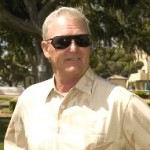 TBP: So when you came back from Vietnam what did you do at the track?
TBP: So when you came back from Vietnam what did you do at the track?
GG: Well racing was different in those days and you learned to do everything from the bottom up - I galloped horses, groomed horses, hot walked horses, you even did most of your own veterinary work back then, you did everything, but I really think it was a good thing because you learned to respect the thoroughbred more than some folks nowadays.GG: My dad had a string of five or six horses and I would help him out and freelance galloping horses. Then I became an Assistant Trainer for a couple of years and then went into training on my own. I started with half a dozen horses at Turf Paradise in Phoenix, Arizona. It was just me, I had no help. I was the trainer, the groom, the exercise rider, it was a one man show - I had horses on ropes, in stalls, in the van and everywhere - it wasn't quite the polished organization you see in most stables nowadays.
TBP: Was there a point where you got a break and things started to get better and turn the corner for you?
GG: Yes there was, and I think when those opportunities come along you better be ready to step through that door and make the most of them because you don't know how many chances you're going to get. I was very fortunate that when I went to Phoenix it was pretty much a one way trip. People sent horses with me from California that they did not need to come back, so it made it easier for me to run those horses in easier spots where they could win so we won a few races. I remember in around 1975 when things were tough and I had just one horse left called Tommy Terrific. I was thinking about what the heck I was going to do. The phone rang and it was John Harris, he said if you come back to California I'll send you three or four more horses. Before the phone was hung up I was in the old Dodge with old Tommy Terrific in the trailer and we were heading to Golden Gate Fields. So I started my long relationship with Harris Farms and Golden Gate.
TBP: Tell us about Lost In The Fog. How did you acquire the horse?
GG: He was in the Ocala two year old sale in Florida. When I looked at him a lot of people, including Jess Jackson, were also looking at him. I said to my client Harry Aleo that we were probably in pretty deep as Jess had a little more money behind him than we did. We bid to $190,000 and someone came back at $195,000. I said to Harry Aleo that I didn't want to go to $200,000. He wanted me to keep bidding but I didn't, so we didn't get the horse. But then I found out that he had a reserve on him of $199,000, and the people came back to me and said we'll sell you the horse for $190,000. I told them we'd think about it as I wanted to see what else I might pick up as the sale still had a few more days to go. Anyway we bought a couple of other horses and came home. About a week later they called and said we know you want this horse - you can have him for $150,000. I was very excited but kept quiet and said I'd have to call Harry. Harry said let's just write them a check. I called them back and said we won't give you $150,000 but we will give you $140,000, and the deal was done.
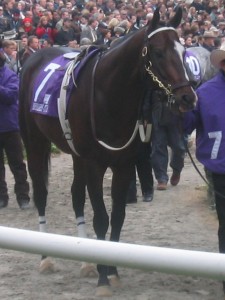
TBP: When you saw him at the sale what was it you liked about him?
GG: Well the main thing was that he was a very well balanced horse and a great mover. Big, stout and good looking. He didn't work particularly fast, I think he worked an eighth in 10.3, but the way he moved he just had no wasted motion whatsoever. I think balance and movement go together and that's a recipe for a good racehorse. The pieces have got to fit together real well and that's really what he brought to the table.
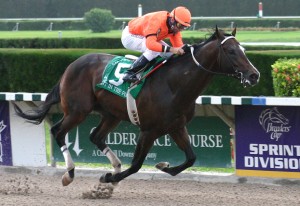 TBP: After the sale did he ship straight to your barn to train?
TBP: After the sale did he ship straight to your barn to train?
GG: Yes they shipped him out to my barn at Golden Gate. The first time we worked him he worked off the charts. Then Russell Baze worked him a half in 46.3. He was developing sore shins and I told Russell that he was going for some rest at the farm. He said "Just let me know when he comes back. I'll be glad to get on him anytime."
TBP: What was Lost In The Fog like to be around, what kind of personality did he have and how was he to train?
GG: He was an easy horse to train, a kind horse to gallop. He was a big stud horse of course, if he wanted to hurt you he could, but the worst thing that he did was bite. The poor groom that rubbed him was paid handsomely but he got a few scars out of the deal too. Other than the biting he was fine. Training him, the thing you had to watch was that when you breezed him you didn't accidentally breeze him too fast, he would look like he was doing nothing and still do a bullet work, so you had to be careful with that.
TBP: What would you say was his best race, his finest hour?
GG: Probably when he won the Kings Bishop at Saratoga. That was a great race and a great day.
TBP: Did it ever cross your mind to stretch him out, maybe look at races like the Met Mile?
GG: It did, because coming along as a three year old he started getting all the Kentucky Derby, Triple Crown hype. I took a lot of flak from a lot of people for not going for the Derby, but I don't think he would have got a mile and a quarter if you'd dropped him out of an airplane. I think a one turn mile would have been possible, he won well over seven eighths, but anything much beyond that, no.
TBP: How do you feel about his Breeders Cup Sprint defeat reflecting back on it now and what do you put it down to?
GG: I can't tell you how many times I've thought about that. The Breeders Cup Sprint was the first time I'd gone over there with him not feeling confident that he was going to win - or as close as you can get to feeling that, let's put it that way. I was walking over with Mike Welch of the Daily Racing Form, I'd been with the horse all day and Mike who is a good friend of mine said "Greg you seem a little troubled." I said "Mike if I could I would just take a left hand turn right here, take this horse back to the barn and not run." There was something not right. When he was being shoed he kept trying to kick the shoer and he never did things like that. Then when I went to put the saddle on him he was rearing up, which again was really out of character for him. When the race started he broke good and coming round the turn he looked like he might win, but then the last eighth he was just a dead horse. I really think looking back that those cancerous tumors were starting to bother him and I think that was probably the start of that right there.
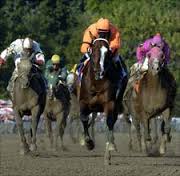
TBP: When Lost In The Fog got sick, how did you find out about it?
GG: I had taken the horse to Churchill Downs, and we had just won a Grade 3 there, the Aristades, he broke the track record. I think that was also one of his best races - he died just a 100 days later. We took him home, I had finally talked Harry Aleo into selling him and we had the horse sold to John Sakura at Hill'n'Dale Farm for ten million dollars.
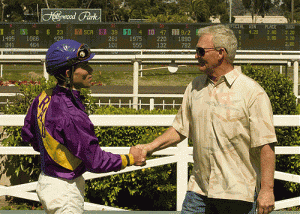 I remember it was on a Friday and he started colicking. I told the vet I wanted him to go to UC Davis right away, he was probably going to be fine but with all that was on the table we couldn't take a chance. We got him up there and by the time he arrived the colicking was over and he was fine. Then the team there said "Do you mind if we check him out anyway and take some pictures". I said sure, and then they came back after they'd taken a look and they said "Greg has this horse ever been cast or been kicked?" I couldn't give them any specific instance so I asked why they were asking, and they said they saw a large mass up by his spleen and they couldn't identify it. So they kept him up there to do a biopsy and a couple of days later we found it was cancerous. They actually wanted to put him down then. So they kept him there and I started driving home. I got about halfway and I said to myself "No - we're not doing that " and I turned around with my trailer and went back for him. I took him back to Golden Gate where we had him for another thirty days. I felt there was still some good time left and there was, but then one evening things were just not good and I called the vet and said "Bring the blue water, we're going to put him down" and that was the end.
I remember it was on a Friday and he started colicking. I told the vet I wanted him to go to UC Davis right away, he was probably going to be fine but with all that was on the table we couldn't take a chance. We got him up there and by the time he arrived the colicking was over and he was fine. Then the team there said "Do you mind if we check him out anyway and take some pictures". I said sure, and then they came back after they'd taken a look and they said "Greg has this horse ever been cast or been kicked?" I couldn't give them any specific instance so I asked why they were asking, and they said they saw a large mass up by his spleen and they couldn't identify it. So they kept him up there to do a biopsy and a couple of days later we found it was cancerous. They actually wanted to put him down then. So they kept him there and I started driving home. I got about halfway and I said to myself "No - we're not doing that " and I turned around with my trailer and went back for him. I took him back to Golden Gate where we had him for another thirty days. I felt there was still some good time left and there was, but then one evening things were just not good and I called the vet and said "Bring the blue water, we're going to put him down" and that was the end.
TBP: How did his owner Harry Aleo take it?
GG: Not well, it was tough on all of us, the horse was like a person. We knew the end was coming, we just didn't know when.
TBP: Well Lost In The Fog certainly had a great run and lit up Northern California racing for a good while. He will never be forgotten. Let's talk about Soviet Problem, the great racemare you trained in the '90s, how did you come to train her?
GG: She was a Harris Farms horse, it was kind of funny because I had previously had a couple of babies out of her mother Nopro Blama, they hadn't been much good, I think I sold one of them for $3000 or so the year before, and this was her fourth or fifth baby, so I asked John Harris how long he was going to keep breeding the mare and he said "Greg just take this one and see what happens" and you know what happened... I think she won 15 from 20 starts, many nice stakes races and got beat a head or so in the Breeders Cup Sprint.
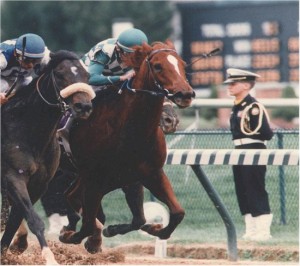
TBP: Did she show you she was a good horse when you started working her?
GG: Right away. I knew she was a runner. And in the Breeders Cup Sprint back then there was no separate fillies and mares sprint, there was only one sprint and you had to go against the boys. She led every step of the way and Cherokee Run caught her at the wire. I have always felt that she should have been given the Eclipse Award that year. I actually talked to Andy Beyer about it three years ago, Andy and I were having dinner in Saratoga and he brought up Soviet Problem and said "Greg, your mare should have won the Eclipse Award that year." He thought that if we'd had TVG and HRTV in '94 there might have been more support for her, but it's history now.
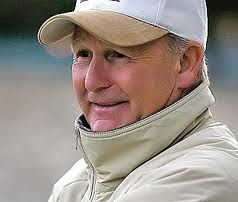
TBP: What was she like to train and be around?
GG: She was a very big, masculine mare. She was ok to train but she was another one you had to be careful with her works as she always wanted to work real fast and made it look like she was going slower than she was, a lot of the good ones are like that. She wasn't really a friendly mare, she didn't care for people too much and liked to be left alone.
TBP: She could route as well as sprint if I recall. Who rode her the most?
GG: Yes she could, she mainly sprinted but she also won a mile and sixteenth on the grass. Russell Baze, Randy Schacht and Chris McCarron rode her. She won just under a million dollars.
TBP: Another great mare you had around that time was Work The Crowd.
GG: Yes, Work The Crowd was more of a distance horse, by Political Ambition. She was a great turf mare, I don't think she ever ran on a turf course that she got beat on. She won on the turf at Bay Meadows, Golden Gate, Hollywood Park, Del Mar, Arlington Park. I don't think I ever saw a horse as enthusiastic about getting on to the turf course as her. As you know they warm up for the turf races on the dirt track and then cross over onto the turf course. I used to watch her warming up and when she moved across on to the turf course she would just start really bouncing. She beat some nice horses and won some nice races in her day.
TBP: How did she compare to Soviet Problem build and personality wise?
GG: Their personalities were a lot different. Work The Crowd liked people, she was always coming to the front of her stall to see what was going on, she was a nice horse to be around. As far as their frames and the way they were built, it was easy to see why one was a really good route horse and the other was a sprinter as Soviet Problem was a big, bullish, quarter horse type and Work The Crowd had that more angular, lengthier build with a real long stride on her.
TBP: In our interview with Billy Antongeorgi we asked him who his favorite horses were and one of them was Victorina, who you trained to win a lot of races.
GG: That's right, Billy loved Victorina. She was one I bought for Harry Aleo, we got her from Mark Casse out of his consignment in Ocala, Florida. She was by Delaware Township and I think we gave $140,000 for her as a two year old in training, which was quite a lot of money given her breeding. She was not a big horse, she was a light framed filly but she just moved so well with this daisy cutter action, all her movement was forward, she didn't go up and down much. First time we ran her was at Santa Rosa where she won. She went on to win at I think eleven different racetracks, I took her everywhere. She really loved and thrived on being a part of racetrack life, if you had twenty horses down the shed row and you were running any that day you could guarantee that she would be the one at the front of her stall looking out whether she was running or not. I turned her out on a farm once for a rest and she came back looking terrible, so from that time on whenever I wanted to give her a break I just kept her at the track. She did a lot better in the barn than on a farm. She won all over the place, she won a graded stakes in Florida and was graded stakes placed at Santa Anita but you could take her to Stockton or Santa Anita, it didn't make any difference to her, she would always run her race. She won from five furlongs to a mile and an eighth, she was just a very good horse.
TBP: What other horses have you had over the years that were your personal favorites?
GG: Well there have been many, but back in the seventies we had a horse called Gold Seal who belonged to my mother and father. We bought him for $1500 and he won 32 races won and close to a quarter of a million, which was a lot of prize money in those days. He was quite a horse. A lot of my other favorites have not necessarily been very high class, they've just been those hard knocking, hard trying claiming horses.
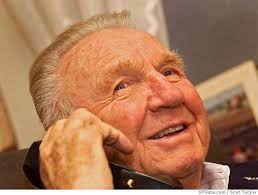
TBP: Tell us about the late Harry Aleo who you trained many good horses for, how did you get introduced and what he was like to train for?
GG: I was running horses at the Sacramento Fair in 1979, and there was a message at the stable gate for me with Harry's name and number. I called him, he said lived in San Francisco and that he would like to get into the racing business. He was very cautious and I was very straightforward and I told him that if you are looking for a safe place to put your money there are safer places than racehorses. But he'd made his money, he was looking to have some fun with his life and he loved the races. A friend of mine had a horse for sale at Pleasanton called Sunny Shy and we bought him for $10,000. We ran him the first time and he ran fourth or fifth, and then we won with him the next time but he was claimed away from us. So we just started claiming some more horses and we did well, Harry was one of those people who luck kind of followed around. As time went on Harry wanted to improve the quality of his horses so we started going to the sales in Kentucky and Florida and again we were lucky, we got some very nice horses over the next few years. Horses like Smokey Stover, Wild Promises and Beyond Brilliant - we bought Beyond Brilliant from the same people we later bought Lost In The Fog from. Harry left you alone to train the horses, he always had input but he would always say to me that the final say would always be mine and he kept to that for the thirty or so years I trained for him. You don't see many relationships in racing these days that last that long, they are few and far between. He was a great man, a great person and I probably wouldn't have achieved what I did in the horse business if it wasn't for Harry Aleo.
TBP: Why did you quit training when you did and do you miss it?
GG: I do miss it. Monday through Friday I don't miss it too bad, Saturday and Sunday I get a little itchy probably. I certainly don't miss it at 4.30 in the morning seven days a week. There were/are a lot of things I want to do with my life that I wasn't getting done and I knew if I carried on training with the 24/7 nature of the business that I probably wouldn't get them done. It's like farming, you never really get time to quit for a while, it was always on your mind no matter what you did. So I kind of made up my mind to finish. Somebody said to me well why don't you just keep a small barn with five horses or so and I said whether I have five or whether I have thirty five, I will still be at the barn 24/7 because that's just the way I do things. I know myself well enough to know that I just needed to take a walk at the time. The game had been very good to me, but another factor was that there were some things going on in racing that had disappointed me a little. People making decisions in the business who shouldn't be making those decisions because they don't really have the background or qualifications to be making them. So rather than "fight city hall" as it were, I just decided to let it be and stop training.
TBP: How did you transition into bloodstock agency and is it a full time or part time situation for you?
GG: After I finished training a couple of people asked me if I'd buy horses for them and I said yes. It wasn't a business at the time, but it has been growing and if I'm not careful I'll soon be back working full time again.... But I do enjoy it, it's something I've been fortunate enough to have been pretty good at. I tell people if I buy you ten horses, two of them are probably going to be really good, two of them are probably going to be worth nothing and there'll be six in between. I have built up a small clientele and it's just like when I was training horses, I don't want a lot of clients. I want a few good clients who understand the business. That makes the job a lot less difficult and quite frankly it will make the success rate a lot higher too.

TBP: Have training methods changed a lot since you started out in the '70s?
GG: There have been tremendous changes. I think we used to breed a more durable, stronger horse. It was nothing for horses to be running when they were seven, eight or nine years old. It's hard to find those kind of horses now. And some of the good horses that win the big races, they have eight or nine starts and that's a career for them. I think too that in years gone by you used to have to be more of a horseman than you do now. The vets control so much of it now, we have so many tools and medicines these days. I think that one of the reasons horses used to last longer was that we didn't have all those solutions before, and when a horse got a problem he went off to the farm and healed up in the proper way. We didn't expedite things with some kind of synthetic solution. I think that's made a tremendous difference in the way people train horses. If you are going to train and you're going to win and you're going to stay at a high level, you're going to have to do some things that you don't want to do. That doesn't mean that you're not taking care of the horse, when things get expedited it doesn't mean you're hurting the horse, but often you are actually shortening their career.
For example, whether to do a cortizone injection on a horse was a big decision when I started training. You called the owner and talked it over, it was a long thought out discussion, you discussed should we do this or should we give the horse time, because injecting a horse's ankle was a big deal then and it wasn't something that you took lightly or for granted. As for medications and drugs in general, there are some good drugs out there that help horses. It is just how they are used and if they are abused that gets people in trouble.
TBP: Lasix has been legal here for several years now but there is talk of it being made illegal in the future. Europe, Ireland, the UK, Australia and many racing nations have thriving racing industries without it and their horses seem to last longer too. Do you think Lasix will one day disappear from US racing?
GG: Well look at the way we run horses here compared to Europe and other countries, they give there horses more time there and they have longer careers as a result. I don't know if Lasix will ever be abolished here, I think it is a helpful drug. People say that people are masking other drugs with it, maybe that's true, maybe it's not true, but I would say that in 99% of cases it's not true. I think if you did take Lasix away racing would just continue and go right on, but people would have to train differently. However if you take it away people will start finding other ways to get ahead as they will in any other competitive business. One thing though I will say is that horse racing should decide which drugs are legal, have a national horse racing commissioner and make the rules across all states the same. It seems like such a simple thing to do. The problem is that none of these jurisdictions want to give up the power that they have, but it would be so much better for racing if this could happen.
TBP: What is your opinion of the synthetic track situation?
GG: I think California was very hasty in the way it went about putting the mandate in place a few years ago.
They were talking about how they were doing it for the safety of the horses. I actually believe it had more to do with money and I think the tracks perceived that the synthetics would be less expensive to maintain and operate and that has turned out not to be the case. I'm not a proponent of synthetic tracks. Another problem is that some horses have problems getting used to the kickback of dirt when they switch between dirt and synthetic. I don't think the experiment has worked and I think that we should just go back to the good dirt and sand mixture that worked for years.
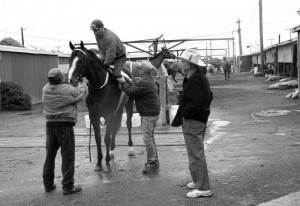
TBP: Looking on the bright side for California racing, what good things are happening?
GG: Well I think we have lost the tracks that we were always going to lose, Bay Meadows and Hollywood Park. I don't know the future of Golden Gate but I think they will continue to run for a while until that property is one day sold. I think that Del Mar and Santa Anita are here to stay, and from what I hear people like what they have done at Los Alamitos, it looks like it's a good track that has a future. I think the future is bright, I do wish we could get some better stallions out here - but guess what, we won the Kentucky Derby this year!
TBP: If you were in charge of racing and you could make some decisions what would you do to improve horse racing?
GG: I don't think I would make a lot of changes, or any major changes as I think we have what we need already, but it is how we administrate it that needs looking at. As we discussed with regard to drug policy, name me a major sport that doesn't have a national commissioner. Basketball, baseball, football, hockey, they all have this in place. Claiming rules are different state to state as well for example, we would be so much better off if we could unite the racing states and have a national policy and set of rules for everything. Drug policy and rules would be understood and uniform across the country and rules would be enforced. You would get one chance, you would get a second chance and the third time you break the drug rules - you're out. I think making all tracks uniform in their type of surface would be a very good thing too.
TBP: What do you think about the Triple Crown and calls to change it's structure? Do you think we were lucky to have three Triple Crown winners in the '70s.
GG: I don't think you should change it, you would undermine it's credibility. And I don't mean to discredit any of the good horses running today, but I think if either Secretariat, Seattle Slew or Affirmed had shown up in 2014 or any recent years, any one of them would have won the Triple Crown that year. They were great horses. When they won it in the '7os the challenge was the same, they were still facing fresh horses being thrown at them in the Preakness and the Belmont just like California Chrome did this year. That's just a part of it and one of the reasons why it is so challenging to win. All of the things that make it difficult are what make it what it is.
------------------------------------------------------------------------------------
ThoroughbredPeople.com
Purina Race Ready
https://www.purinamills.com/horse-feed/products/detail/purina-race-ready-horse-feed
